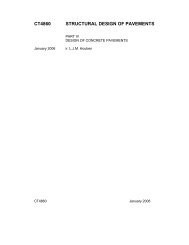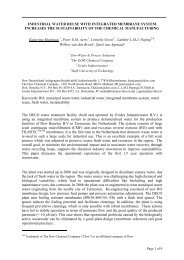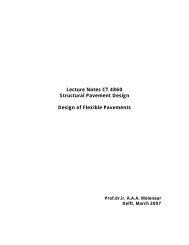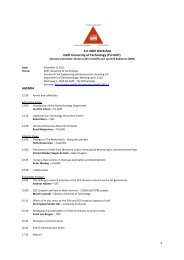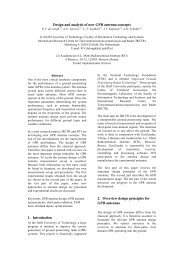CHAPTER 5 CONCRETE PAVEMENTS - TU Delft
CHAPTER 5 CONCRETE PAVEMENTS - TU Delft
CHAPTER 5 CONCRETE PAVEMENTS - TU Delft
Create successful ePaper yourself
Turn your PDF publications into a flip-book with our unique Google optimized e-Paper software.
The value of the limit temperature gradient ∆tl follows from equalizing the equations<br />
5.3 and 5.4 for both the center of the longitudinal slab edge and the center of the<br />
transverse slab edge.<br />
5.3.4 Stresses due to traffic loadings:<br />
The basic theory for the structural design of plain concrete pavements has been<br />
developed by Westergaard in 1926 (8). Westergaard considers a single, fully<br />
supported slab (without any load transfer to adjacent slabs) of the concrete<br />
pavement. The slab is resting on an elastic foundation, i.e. vertical elastic springs<br />
with a stiffness k (the modulus of substructure reaction k, see 5.3.2).<br />
Westergaard developed equations for the maximum flexural tensile stress in the<br />
concrete slab and the maximum vertical displacement (deflection) of the concrete<br />
slab due to a single wheel load, located in the interior (middle), along the edge or in a<br />
corner of the slab (figure 5.9). In the cases that the single wheel load is in the interior<br />
or along the edge of the slab, the flexural tensile stress is maximal at the bottom of<br />
the slab in the center of the wheel load. In the case that the single wheel load is in a<br />
corner of the slab, the flexural tensile stress is maximum at the top of the slab at<br />
some distance (around 1 m) of the corner.<br />
Figure 5.9: Positions of the load in Westergaard’s theory.<br />
The edge loading case is most important for the structural design of plain concrete<br />
pavements. There exist numerous Westergaard-equations for this loading case, but<br />
the most correct equations (which yield nearly the same result) are the following<br />
‘new’ Westergaard-equations from 1948 (9,10):<br />
circular loading area<br />
( 1 + υ)<br />
( 3 + υ)<br />
3<br />
3 P ⎧ ⎛ E h ⎞ 4 1 − υ<br />
σ =<br />
⎨l<br />
n ⎜<br />
⎟ + 1.<br />
84 − υ + + 1.<br />
18 2<br />
4<br />
π h ⎩ ⎝100<br />
k a ⎠ 3 2<br />
semi-circular loading area<br />
( 1 + υ)<br />
( 3 + υ)<br />
( ) ⎬<br />
⎭ ⎫ a<br />
1 + υ<br />
2 (5.5)<br />
3<br />
3 P ⎪⎧<br />
⎛ E h ⎞ 4<br />
a ⎪⎫<br />
2<br />
σ =<br />
⎨l<br />
n<br />
+ − + ( + ) ⎬<br />
⎪⎩<br />
⎜<br />
⎟ 3.<br />
84 υ 0.<br />
5 1 2 υ<br />
(5.6)<br />
2<br />
4<br />
π h ⎝100<br />
k a2<br />
⎠ 3<br />
l ⎪⎭<br />
l<br />
173





